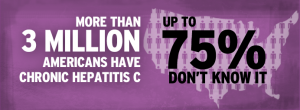 The past three decades have seen many incremental advances in the diagnosis and treatments for viral hepatitis. When I started practice, the only commonly identified causes of viral hepatitis were types A, which typically is short-lived and without long term ill effect, and hepatitis B, which can cause chronic liver problems and liver cancer. Hepatitis B cases in this country have been steadily dropping since the introduction of an effective vaccination series which is now started at birth. Unlike hepatitis A and B there are no vaccinations to prevent hepatitis C. For a number of years now, we have had a test to identify hepatitis C. The initial benefit of having a test to identify hepatitis C was to protect the blood supply which prevented transmission from blood transfusions thereby starting a slow decline in the number of new cases. However, as more and more people have been tested, we now know that as many as 3 million Americans, predominantly baby boomers, may be carrying the virus; and most people who carry the virus are not aware of it.
The past three decades have seen many incremental advances in the diagnosis and treatments for viral hepatitis. When I started practice, the only commonly identified causes of viral hepatitis were types A, which typically is short-lived and without long term ill effect, and hepatitis B, which can cause chronic liver problems and liver cancer. Hepatitis B cases in this country have been steadily dropping since the introduction of an effective vaccination series which is now started at birth. Unlike hepatitis A and B there are no vaccinations to prevent hepatitis C. For a number of years now, we have had a test to identify hepatitis C. The initial benefit of having a test to identify hepatitis C was to protect the blood supply which prevented transmission from blood transfusions thereby starting a slow decline in the number of new cases. However, as more and more people have been tested, we now know that as many as 3 million Americans, predominantly baby boomers, may be carrying the virus; and most people who carry the virus are not aware of it.
Though most people with hepatitis C never develop serious complications, an important minority develop cirrhosis, liver failure, or liver cancer. Until late stage complications arise, the infection is usually asymptomatic; and usual liver blood tests are either normal or show low grade abnormalities that may be falsely attributed to medications that the person is taking. Though progress in the treatment of hepatitis C up to now has been remarkable, many of the treatments have been less than optimal. They can take almost a year, require a weekly injection plus as many as 18 pills per day for treatment of the infection and the side effects from the medications, and be accompanied by unpleasant side effects – with cure rates between 40 and 80% depending on the strain with which one is infected.
With the recent advent of two new medications, Olysio (simeprevir) and Sovaldi (sofosbuvir), we appear to be quickly entering a new era in the treatment of this potentially serious condition. In some cases treatment can now be as short as 12 weeks with pills only and with significantly fewer side effects and cure rates of over 90%.
An analysis of recent trends published in the Annals of Internal Medicine suggests that in the United States alone, with the adoption of universal hepatitis C screening, almost a million new candidates for treatment could be identified. With the wide- scale adoption of the newer treatments, the disease could become a rarity in the next twenty years, preventing over a quarter million liver-related deaths.
The new drugs, though, come with a steep price; $1000 per pill with an average estimated cost of $84,000 per treatment and a growing debate over a fair price for breakthrough drugs that are the culmination of decades of research that can prevent costly medical complications in years to come. Plus, in a time of strained health care budgets, who will pay the many billions of dollars for the treatments in this country and in poorer developing countries?
Wish to know your hepatitis C status? The easiest way is to donate blood – since 1992 all donated blood is screened and you would be notified if infected. Haven’t donated blood or ever been tested? Let us know at the time of your physical and we can include a hepatitis C blood test with your complete blood work and cholesterol tests.
By Dr Ed Taubman Olney Maryland 301-774-5400
Looking for a high quality primary care practice? We are now accepting new patients
